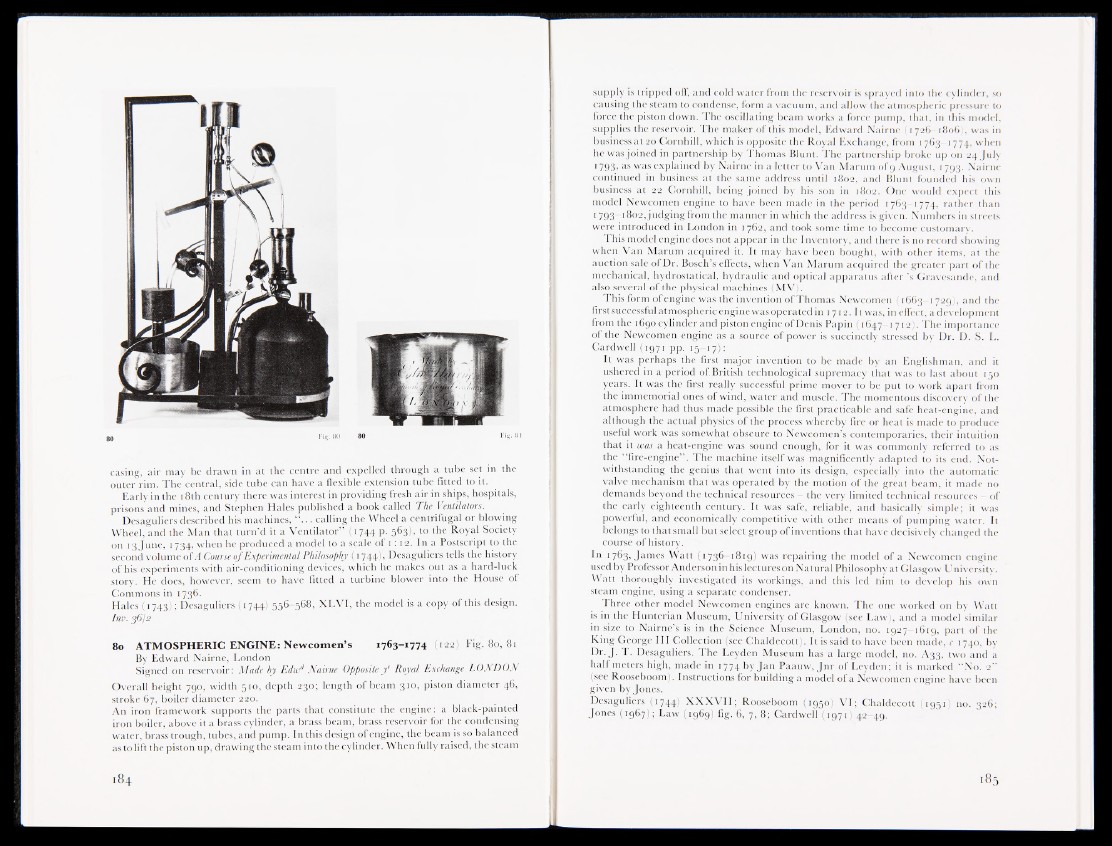
casing, air may be drawn in at the centre and expelled through a tube set in the
outer rim. The central, side tube can have a flexible extension tube fitted to it.
Early in the 18th century there was interest in providing fresh air in ships, hospitals,
prisons and mines, and Stephen Hales published a book called The Ventilators.
Desaguliers described his machines, “ ... calling the Wheel a centrifugal or blowing
Wheel, and the Man that turn’d it a Ventilator” (1744 p. 563), to the Royal Society
on 13 June, 1734, when he produced a model to a scale of 1:12. In a Postscript to the
second volume of A Course of Experimental Philosophy (1744) > Desaguliers tells the history
of his experiments with air-conditioning devices, which he makes out as-a hard-luck
story. He does, however, seem to have fitted a turbine blower into the House of
Commons in 1736.
Hales (1743)1 Desaguliers (4 744) 556-568, XLVI, the model is a copy of this design.
Inv. 36)2
80 ATMOSPHERIC ENGINE: Newcomen’s 1763-1774 (122)1^.80,81
By Edward Nairne, London
Signed on reservoir: Made by Edwd Nairne Opposite f Royal Exchange LONDON
Overall height 790, width 510, depth 230; length of beam 310, piston diameter 46,
stroke 67, boiler diameter 220.
An iron framework supports the parts that constitute the engine: a‘i>lack-painted
iron boiler, above it a brass cylinder, a brass beam, brass reservoir for the condensing
water, brass trough, tubes, and pump. In this design of engine, the beam is so balanced
as to lift the piston up, drawing the steam into the cylinder. When fully raised, the steam
supply is tripped off, and cold water from the reservoir is sprayed into the cylinder, so
causing the steam to condense, form a vacuum, and allow the atmospheric pressure to
force the piston down. The oscillating beam works a force pump, that, in this model,
supplies the reservoir. The maker of this model, Edward Nairne (1726—1806), was in
business at 20 Cornhill, which is opposite the Royal Exchange, from 1763—1774, when
he was joined in partnership by Thomas Blunt. The partnership broke up on 24 July
1793, as was explained by Nairne in a letter to Van Marum of 9 August, t 793. Nairne
continued in business at the same address until 1802, and Blunt founded his own
business at 22 Cornhill, being joined by his son in 1802. One would expect this
model Newcomen engine to have been made in the period 1763-1774, rather than
1793-1802, judging from the manner in which the address is given. Numbers in streets
were introduced in London in 1762, and took some time to become customary.
This model engine does not appear in the Inventory, and there is no record showing
when Van Marum acquired it. It may have been bought, with other items, at the
auction sale of Dr. Bosch’s effects, when Van Marum acquired the greater part of the
mechanical, hydrostatical, hydraulic and optical apparatus after’s Gravcsandc, and
also several of the physical machines (MV).
This form of engine was the invention of Thomas Newcomen (1663—1729), and the
first successful atmospheric engine was operated in 1712. It was, in effect, a development
from the 1690 cylinder and piston engine of Denis Papin (1647-1712). The importance
of the Newcomen engine as a source of power is succinctly stressed by Dr. D. S. L.
Cardwell (1971 pp. 15-17):
It was perhaps the first major invention to be made by an Englishman, and it
ushered in a period of.British technological supremacy that was to last about 150
years. It was the first really successful prime mover to be put to work apart from
the immemorial ones of wind, water and muscle. The momentous discovery of the
atmosphere had thus made possible the first practicable and safe heat-engine, and
although the actual physics of the process whereby fire or heat is made to produce
useful work was somewhat obscure to Newcomen’s contemporaries, their intuition
that it was a heat-engine was sound enough, for it was commonly referred to as
the “ fire-engine” . The machine itself was magnificently adapted to its end. Notwithstanding
the genius that went into its design, especially into the automatic
valve mechanism that was operated by the motion of the great beam, it made no
demands beyond the technical resources — the very limited technical resources — of
the early eighteenth century. It was safe, reliable, and basically simple; it was
powerful, and economically competitive with other means of pumping water. It
belongs to that small but select group of inventions that have decisively changed the
course of history.
In 1763, James Watt (1736—1819) was repairing the model of a Newcomen engine
used by Professor Anderson in his lectures on Natural Philosophy at Glasgow University.
Watt thoroughly investigated its workings, and this led liim to develop his own
steam engine, using a separate condenser.
Three other model Newcomen engines are known. The one worked on by Watt
is in the Hunterian Museum, University of Glasgow (see Law), and a model similar
in size to Nairne’s is in the Science Museum, London, no. 1927—1619, part of the
King George III Collectionjsee Chaldecott). It is said to have been made, c 1740, by
Dr. J. T. Desaguliers. The Leyden Museum has a large model, no. A33, two and a
half meters high, made in 1774 by Jan Paauw, Jnr of Leyden; it is marked “No. 2”
(see Rooseboom), Instructions for building a model of a Newcomen engine have been
given by Jones.
Desaguliers (1744) XXXVII; Rooseboom (1950) VI; Chaldecott (1951) no. 326;
Jones (1967); Law (1969) fig. 6, 7, 8; Cardwell (1971) 42—49.